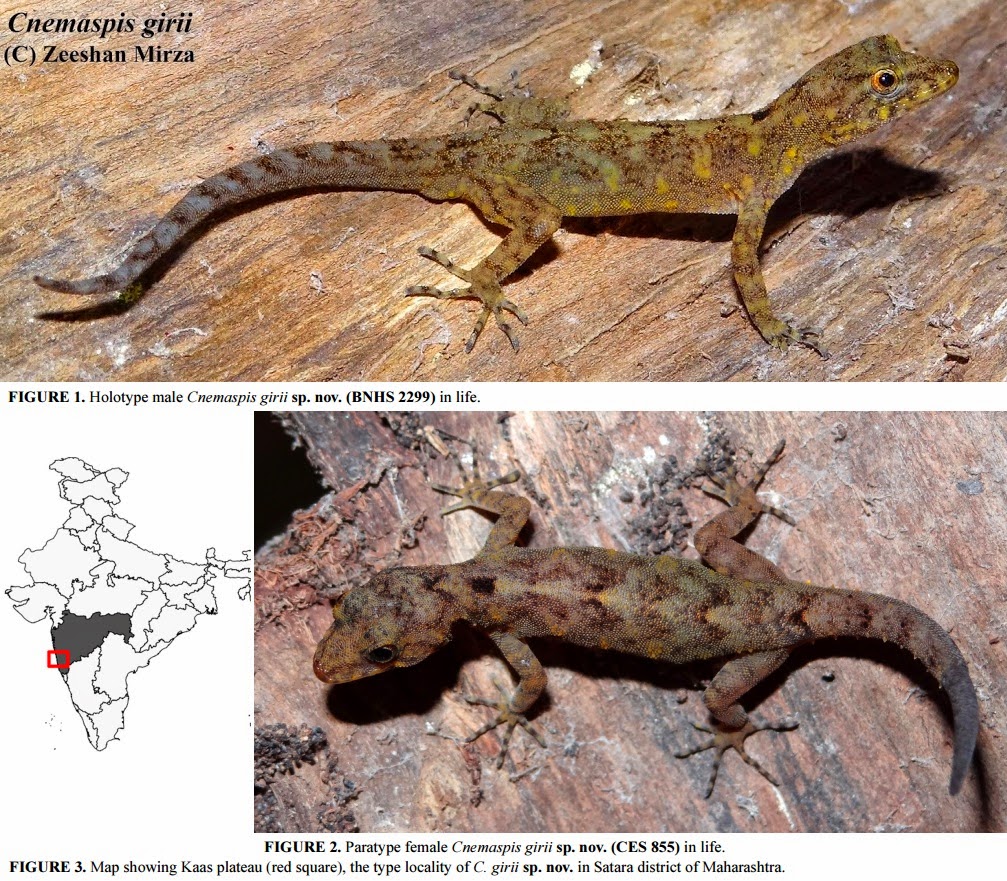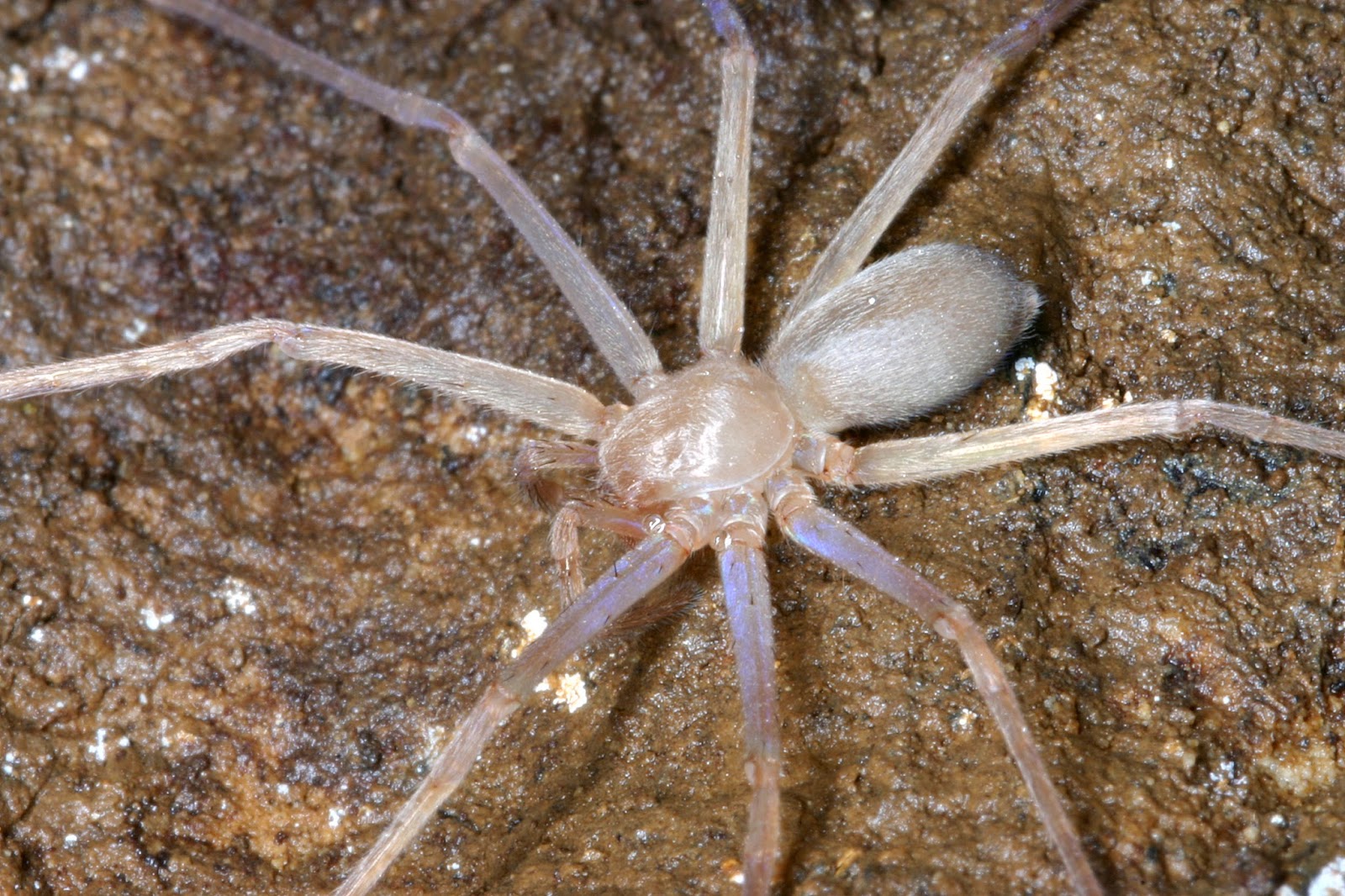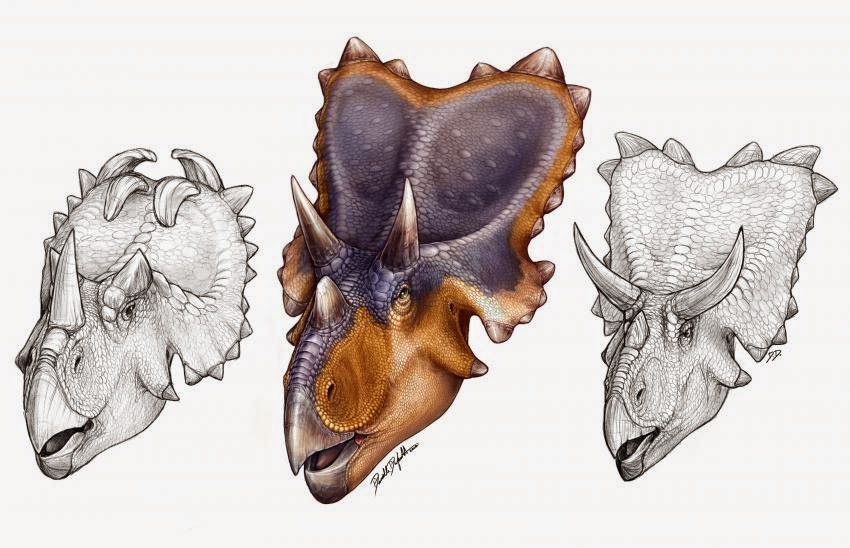[Most Recent Entries] [Calendar View]
Wednesday, June 18th, 2014
| Time | Event | ||||
| 2:45p | [Herpetology • 2014] Cnemaspis girii • A New Species of Gecko of the Genus Cnemaspis Strauch, 1887 from the Kaas plateau of the northern Western Ghats of Maharashtra, western India
Abstract A new species of the gekkonid genus Cnemaspis is described from the lateritic plateau of the northern Western Ghats of Maharashtra, western India. The new species is diagnosed by the following suite of characters: small sized Cnemaspis, SVL less than 35 mm (21.52–33.65). Dorsal scales on trunk heterogeneous, granular scales intermixed with large smooth scales and large keeled conical tubercles. Spine-like tubercles absent on flank. Two pairs of postmentals, inner postmentals separated by a single enlarged chin shield. Ventral scales on trunk smooth, imbricate, 26–28 scales across the belly between the lowest rows of dorsal scales. Subdigital scansors smooth, entire, unnotched; lamellae under digit IV of pes 17-20.Males with four femoral pores on each thigh and lacking pre-cloacal pores. Median row of sub-caudals smooth, imbricate and not enlarged. The present discovery highlights the need for dedicated herpetofaunal explorations in the northern Western Ghats to ascertain the exact diversity and distribution of Cnemaspis in India to elucidate the apparent disjunct distribution of the genus in the country. Keywords: new species, Gekkonidae, Cnemaspis, taxonomy, Kaas plateau, Western Ghats, India Etymology: The specific epithet is a patronym, honouring Dr. Varad Giri of Bombay Natural History Society for his immense contribution to Indian herpetology and continued support to the authors.
Mirza, Zeeshan A., Saunak Pal, Harshal Bhosale & Rajesh V. Sanap. 2014. A New Species of Gecko of the Genus Cnemaspis Strauch, 1887 from the Western Ghats, India. Zootaxa. 3815(4): 494–506. | ||||
| 3:18p | [Arachnology • 2012] Revision of the Genus Sinopoda Jäger 1999 (Sparassidae: Heteropodinae) in Laos; with discovery of the first eyeless huntsman spider species - Sinopoda scurion
Abstract The genus Sinopoda Jäger, 1999 is recorded for the first time in Laos. Nine new species are described: Sinopoda steineri spec. nov. (female; Luang Nam Tha), S. tham spec. nov. (male, female; Oudomxai), S. sitkao spec. nov. (female; Luang Prabang), S. taa spec. nov. (female; Luang Prabang), S. suang spec. nov. (female; Huaphan), S. peet spec. nov. (female; Huaphan), S. guap spec. nov. (female; Khammuan), S. soong spec. nov. (female; Khammuan), S. scurion spec. nov. (female; Khammuan). All species have been collected from caves. Sinopoda scurion spec. nov. represents the first record of an eyeless huntsman spider, S. guap spec. nov. exhibits only small lenses of six eyes (AME lacking), S. soong spec. nov. has only two small eye lenses. Four immature individuals (Sinopoda sp. indet. A–D) exhibited a reduced size or number of eyes, they are listed including their localities although they could not be identified to species level. Key words: taxonomy, systematics, new species, troglomorphy JÄGER, P. 2012. Revision of the Genus Sinopoda Jäger 1999 in Laos with discovery of the first eyeless huntsman spider species (Sparassidae: Heteropodinae). Zootaxa. 3415: 37-57 http://www.mapress.com/zootaxa/2012/f/zt | ||||
| 5:08p | [Paleontology • 2014] Mercuriceratops gemini • A New chasmosaurine from northern Laramidia expands Frill Disparity in ceratopsid Dinosaurs
Abstract A new taxon of chasmosaurine ceratopsid demonstrates unexpected disparity in parietosquamosal frill shape among ceratopsid dinosaurs early in their evolutionary radiation. The new taxon is described based on two apomorphic squamosals collected from approximately time equivalent (approximately 77 million years old) sections of the upper Judith River Formation, Montana, and the lower Dinosaur Park Formation of Dinosaur Provincial Park, Alberta. It is referred to Chasmosaurinae based on the inferred elongate morphology. The typical chasmosaurine squamosal forms an obtuse triangle in dorsal view that tapers towards the posterolateral corner of the frill. In the dorsal view of the new taxon, the lateral margin of the squamosal is hatchet-shaped with the posterior portion modified into a constricted narrow bar that would have supported the lateral margin of a robust parietal. The new taxon represents the oldest chasmosaurine from Canada, and the first pre-Maastrichtian ceratopsid to have been collected on both sides of the Canada–US border, with a minimum north–south range of 380 km. This squamosal morphology would have given the frill of the new taxon a unique dorsal profile that represents evolutionary experimentation in frill signalling near the origin of chasmosaurine ceratopsids and reinforces biogeographic differences between northern and southern faunal provinces in the Campanian of North America. Keywords: Chasmosaurinae, Mercuriceratops gemini, Campanian, Judith River Formation, Dinosaur Park Formation, Laramidia Ryan, M. J.; Evans, D. C.; Currie, P. J.; Loewen, M. A. 2014. A New chasmosaurine from northern Laramidia expands Frill Disparity in ceratopsid Dinosaurs. Naturwissenschaften. 101(6); 505-512 doi: dx.doi.org/10.1007/s00114-014-1183-1 Mercuriceratops: New Long-Horned Dinosaur Discovered: http://www.sci-news.com/paleontology/sci |
| << Previous Day |
2014/06/18 [Calendar] |
Next Day >> |







